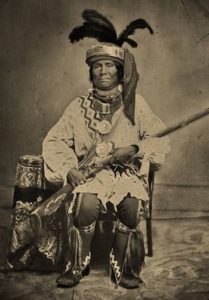
Chief Billy Bowlegs
*November is Native American history month, and on this date, Chief Billy Bowlegs's birth in 1810 is celebrated.
He was a Native American leader of the Seminoles and slave owner of Africans in Florida during the Second and Third Seminole Wars against the United States. Bowlegs was born into a family of hereditary chiefs descended from Cowkeeper of the Oconee tribe of the Seminole in the village of Cuscowilla. This was on the Alachua savannah (present-day Payne's Prairie, near Micanopy, Florida). His father's name was Secoffee, while it is thought that Chief Micanopy was his uncle. The surname "Bowlegs" may be an alternate spelling of Bolek, a preceding Seminole chief.
Bowlegs was sometimes called Billy Bolek (Holata Micco, Halpatter-Micco, Halbutta Micco, and Halpuda Mikko in Seminole, meaning "Alligator Chief"). Although Bowlegs signed the Treaty of Payne's Landing of 1832, he refused to leave Florida. He was not well-noted at the beginning of the Second Seminole War (roughly 1835 to 1842). After the capture and subsequent death of Osceola and the death of Micanopy, and the loss of other prominent Seminole chiefs, Bowlegs and his band of 200 warriors became some of the most prominent fighters surviving at the time hostilities ended on August 14, 1842.
To impress the Seminole chiefs, the US government brought Bowlegs to Washington, D.C., to underline the power of the United States. Bowlegs and his community lived in relative peace until 1855. A group of army engineers and surveyors invaded his territory in southwestern Florida, cutting down banana trees and destroying other property while building forts. Some historians have viewed these actions as an intentional provocation to make Bowlegs react so the settlers would have a reason to force the Seminoles out. If so, the provocation worked: Bowlegs led his warriors in sporadic attacks against settlers for the next few years in what is known as the Third Seminole War. The Army could not subdue his warfare to defend himself and his community. In early 1858, Chief Wild Cat of the Western Seminole was brought back from Indian Territory to convince Bowlegs to relocate voluntarily.
The US government offered Bowlegs $10,000 and each of his chiefs $1000 if they did so. Warriors and non-warriors were offered less. They initially refused, but later that year, the band of 123 agreed to relocate. Bowleg's Creek in downtown Fort Myers, Florida, is named after him as this was where he was forced to surrender. In 1859, Bowlegs and his followers arrived in New Orleans, heading to Arkansas and their new home in the Indian Territory. A journalist described the chief as having "two wives, one son, five daughters, fifty slaves, and a hundred thousand dollars in hard cash."
After reaching Indian Territory, Bowlegs became a leading chief. He and his daughters became prominent landholders and slaveowners. His slaveholding put him in the category of prominent Southern planters, those with more than 20 slaves. Billy Bowlegs gained distinction as a captain in the Union Army during the American Civil War and his intersectionality with African slaves in America. One of the last Seminole leaders to resist, he eventually moved to Indian Territory, present-day Oklahoma. Billy Bowlegs died in 1864.